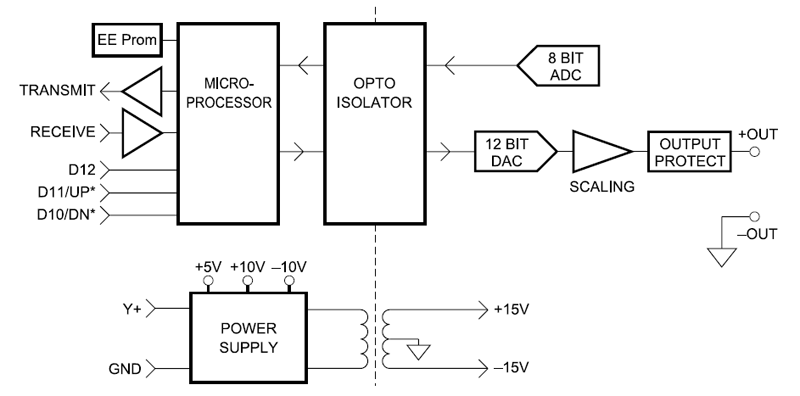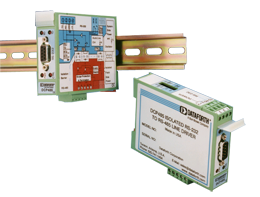SCM9B-3000/4000
Computer-to-Analog Output Modules
The SCM9B-3000/4000 series are complete computer-to-analog output interfaces. They are designed to be mounted remotely from a host computer and communicate, in ASCII, with standard RS-232 and RS-485 serial ports. Simple ASCII commands are used to control a 12-bit DAC (Digital-to-Analog Converter) which is scaled to provide commonly used current and voltage ranges. An 8-bit CMOS microprocessor provides an intelligent interface between the host and the DAC. The 3000/4000 are compatible with the 1000/2000 input modules and may be mixed in any order.
The modules are easy to use. You do not need engineering experience in complicated data acquisition hardware. This modular approach to data acquisition is extremely flexible, easy to use and cost effective. The modules can be mixed and matched to fit the application. They can be placed remote from the host and from each other. You can string up to 124 modules on one set of wires.
Although software is not required, utility software (SCM9B-S1000) is available on IBM-compatible diskette to make the 3000/4000 easier to learn and use. S1000 software is provided at no charge on request with a purchase order and is not copy protected.
The modules are easy to use. You do not need engineering experience in complicated data acquisition hardware. This modular approach to data acquisition is extremely flexible, easy to use and cost effective. The modules can be mixed and matched to fit the application. They can be placed remote from the host and from each other. You can string up to 124 modules on one set of wires.
Although software is not required, utility software (SCM9B-S1000) is available on IBM-compatible diskette to make the 3000/4000 easier to learn and use. S1000 software is provided at no charge on request with a purchase order and is not copy protected.
Certifications

Documents
Product Availability
Usually stock to 2-3 weeks
Dimensions & Accessories
Features
- Analog Output Ranges: 0-1V, ±1V, 0-5V, ±5V, 0-10V, ±10V, 0-20mA, 4-20mA
- Communicates in ASCII with RS-232 or RS-485 Serial Ports
- Programmable High/Low Output Limits
- 500Vrms Output Isolation
- 12-bit Output Resolution
- Scaling in Engineering Units
- Data Rates: 300 to 38,400bps
- Nonvolatile Digital Calibration
- Output Protection: 240VAC (Current Output) ±30V (Voltage Outputs)
- Direct Connection to ‘Dumb’ Terminals or Modems
- Requires +10 to +30VDC Unregulated Supply
- May be Located up to 10,000 Feet from Host (RS-485)
- Addressable: up to 124 Units per Serial Port
- "Bumpless" Manual Control Inputs
- CE Compliant
Block Diagram

Ordering
NOTE: Data in below table can be filtered. Please use the
to make your selection. If you have any questions about the displayed data,
please contact Customer Service at +1 520-741-1404 or sales@dataforth.com
FAQ
Due to resource constraints on my computer, I'm unable to open the three dimensional CAD models provided on your website. Does Dataforth provide two demensional CAD models for download as well?
Two dimensional CAD models can be generated upon customer request. Please contact Customer Service for assistance.
How does the load resistance of a module affect the noise at the output?
Noise at the output of a module is independent of load resistance.
How do I convert an RMS voltage to its corresponding peak voltage?
To convert an RMS voltage to its corresponding peak voltage, you simply take the RMS voltage value and multiply it by the square root of 2, or roughly 1.414.
For example, 1500Vrms corresponds to a peak voltage of 1500 * 1.414 = 2121 Vp
If the input range of my signal conditioner is -1V to +1V and the output range is 0 to 10V, does this mean that it ignores polarity?
A signal conditioner with these I/O ranges does not mean that the module ignores the polarity of your voltage input. The output of voltage input modules are scaled linearly, meaning an input of -1V would correspond to an output of 0V, an input of 0V would correspond to an output of 5V, an input of +1V would correspond to an output of 10V, and so on.
Analog Devices announced a last time buy and discontinuance of their signal conditioning modules. Can I replace them with Dataforth signal conditioning modules?
Yes, in general, Dataforth signal conditioning modules are a direct replacement for all Analog Devices signal conditioning modules. e.g. "SCM5B35-xx: Linearized 4-Wire RTD Input Modules" will replace Analog Devices "5B35: Isolated 4 Wire RTD Input Signal Conditioning Module".
Please note that Dataforth signal conditioning modules are RoHS II compliant.
Can Dataforth provide calibration reports for modules I purchased?
Yes we can provide calibration reports for the modules that you purchased.
You can either
a) visit https://www.dataforth.com/TestDataReport.aspx to search for Test Report Datasheets by Serial Number or
b) you can send us a list of model numbers and their serial numbers to support@dataforth.com
Custom Modules
Below is a list of existing custom modules. If you don't see a module matching your target specifications, contact Customer Service and Application Support to discuss design guidelines and
design feasibility. Customer Service and Application Support can be reached at
sales@dataforth.com or +1-800-444-7644.
NOTE: Data in below table can be filtered. Please use the
to make your selection. If you have any questions about the displayed data,
please contact Customer Service at +1 520-741-1404 or sales@dataforth.com
* ... Status Codes: PR = Production, PT = Prototypes, QU = Quoted
We want your feedback!
We are interested in your feedback regarding our products. Please let us know what you think and if you have any questions regarding the SCM5B32 and how this product could apply to your application. Your feedback is very valuable to us and very much appreciated.
Was this content helpful?
Thank you for your feedback!






